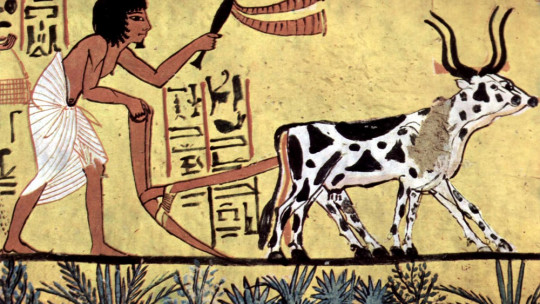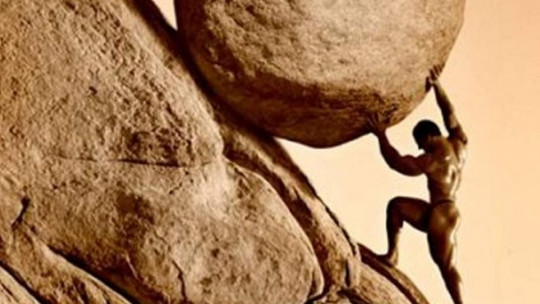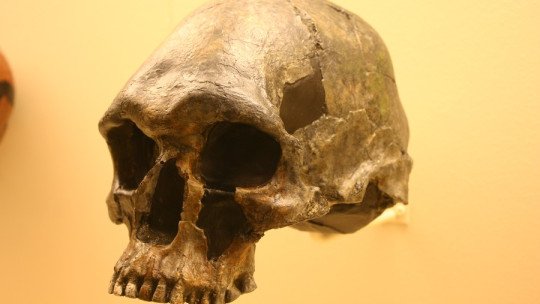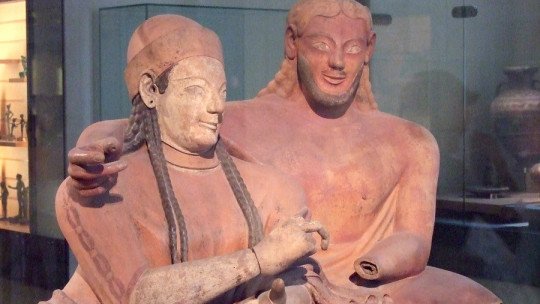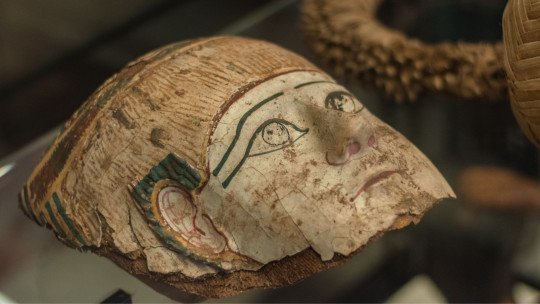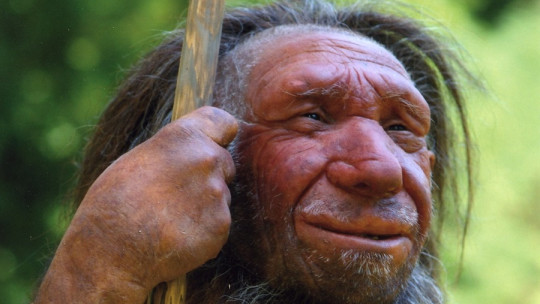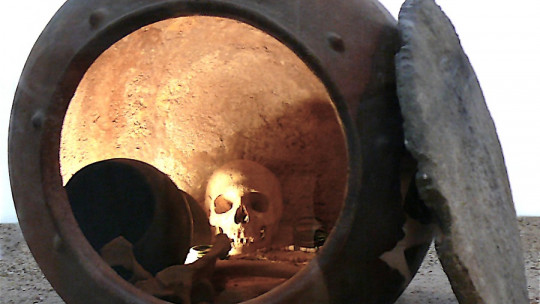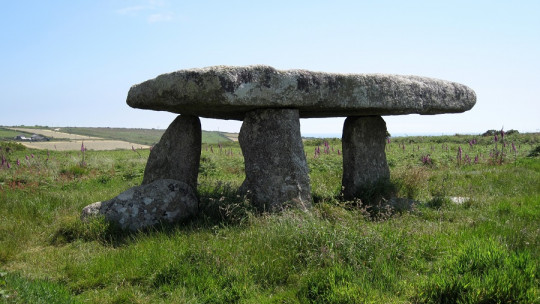
Death is an aspect addressed in all cultures. All over the world a moment is dedicated to those who have just left, holding a ceremony in their memory.
A question that archaeologists have asked themselves is since when do human beings celebrate and bury their dead. Is it something exclusive to our species or have there been other hominids who have buried their dead?
Next we are going to talk about funeral rituals in the stone age, that is, the Paleolithic and the Neolithic, in addition to understanding the difficulty of knowing if they really had a concept of death.
Funeral rituals in the Stone Age: characteristics and discoveries
Death is an event that is accompanied by rituals in practically all cultures Wherever you are, in all cultures, when someone dies, some tribute is prepared for them. This may consist of a Western-style burial, with the body inside a coffin that, after saying goodbye, will be cremated or buried. In other places in the world the corpse is thrown into the sea, respectfully left out in the open so that the vultures can eat it, or it is even defleshed and its bones placed in decorative urns.
It is clear that the abstract idea of death is present in all human beings regardless of how “complex” or “civilized” their culture is.
However, a question that archaeologists have always asked is since when do modern (and not so modern) humans bury our dead. A deliberate burial is synonymous with understanding the concept of death and that is why we have tried to understand up to what point this abstract idea could appear in our minds.
Given the existence of archaeological sites in which human bones have been found apparently placed deliberately, It has been suggested that our ancestors could understand what death was Death is an abstract idea, which is not limited to understanding that something that was alive is no longer alive: it is understanding that it is an irreversible phenomenon, that whoever dies is gone forever.
Funeral rituals in the Stone Age have been an object of extensive study since, if discovered, they would be confirmation of abstract thinking in our ancestors.
Traditionally it has been thought that only modern humans buried their dead, however, archaeologists are increasingly critical of this idea Let’s see what funeral rituals were like in the Stone Age, or at least the interpretation that has been made of them.
Rituals in the Paleolithic
The Paleolithic is the oldest period in Prehistory. Although at this time the manufacture of certain tools can already be found, The idea that hominids could bury their loved ones is still debatable This period is subdivided into three: lower paleolithic, middle paleolithic and upper paleolithic.
Lower Paleolithic
A very widespread belief among the population is that our oldest ancestors did not treat their most recent dead in a special way. The absence of deliberate burials has raised doubts about whether they understood what death was or had abstract ideas, assuming that they must not be very intelligent.
However, this idea changed with the findings of the Sima de los Huesos in Atapuerca, with bone remains dating back 430,000 years and found in a place that does not seem to have any domestic use.
Is about a kind of cave that leads to a natural well, in which the bones of at least 28 hominins have been found, along with remains of quartzite tools. Given how remote it is and that it does not seem to be used daily, it has been interpreted that the Sima de los Huesos is a type of prehistoric cemetery.
Although there are those who think that these bones could be found there by accident, as if brought by a flood or by a predator, the theory of deliberate burial is the one that makes the most sense. If there had been floods, not only the remains of hominids would have been found, but also other animals This site, if it is true that it is a burial place, would confirm the existence of deliberate burials of more than 200,000 years.
In one of the most difficult to access chambers of the Rising Star Cave in South Africa, 15 human-like skeletal remains have been found. This hypothetical new species has been called Homo nalediand it appears to be another deliberate burial.
There is no evidence of a natural disaster to explain why the skeletal remains were there, nor any sediment or water that could be due to a flood. Apart from the bones of an owl, there are no remains of other animals or possible predators that brought those bones there.
Middle Paleolithic
As we enter the Middle Paleolithic we find more remains of deliberate funerary rituals. It seems that some Neanderthals carried out rituals for their dead, but in a somewhat violent way perhaps for our modern Western vision: they stripped the corpses and broke the joints. It has been hypothesized that they could perform ritual cannibalism with their dead.
There is evidence of Possible deliberate burials made by Neanderthals in Pontnewydd Cave in Wales, dating back 230,000 years Between the transition from the Middle to the Upper Paleolithic, Neanderthals carried out increasingly sophisticated burials, both for young children and their elders. This suggests that their society was more egalitarian than one might think, in which age was not a distinguishing factor.
Likewise, there are no confirmed remains of grave goods in these Neanderthal tombs. This is quite significant, since the trousseau is an indicator of ceremonial thinking, of leaving things for the dead to take to the other world. Likewise, it is assumed that Neanderthals could have had a concept of death, or at least understood that it was an irreversible phenomenon.
As for modern humans u Homo sapiens, it is widely known that they have traditionally been associated with being the only ones capable of performing funeral rituals. This, based on what has already been seen, has been called into question. What is clear is that The first deliberate burials of modern humans were much more sophisticated compared to those of their ancestors or other species of humans
One of the first deliberate burials found made by Homo sapiens It is found in Israel and dates back about 100,000 years. In it, delicately placed bone remains were found, with trousseau composed mainly of animal bones.
Superior paleolithic
But it was not until the Upper Paleolithic that there was a “boom” in funerary rituals, since there were quite a few bone remains found from this time. An interesting case is found in the United Kingdom, in Goat’s Cave. William Buckland in 1823 found in this cave, located on the Gower Peninsula, Wales, some very old bone remains, painted red
Buckland was a great follower of the Bible, which made him unable to think that the World was more than 5,000 years old. He thought that those bones were from some prostitute brought at the time of the Roman invasion of Britain, and for this reason he called her the Red Lady of Paviland. Ironically, this young lady was actually a male, she would have been 25 or 30 years old when she died and lived about 33,000 years ago and, to make matters worse, It was accompanied by skeletal remains of long-extinct animals which not even the Romans could know.
The Red Lady of Paviland had a mammoth ivory bracelet, an earring, and numerous shells and bone remains. Her body should have been buried with clothes and shoes. The nature of this burial suggests that he was an important man, considering the possibility that he was a shaman and that the trousseau that accompanied him were elements of his ritual during his lifetime.
Rituals in the Mesolithic
There are few complete human remains attributed to the Mesolithic, suggesting that there were few burials or that other methods of viewing the deceased were practiced. Among the most common practices could be considered defleshing, that is, removing the meat from the bones. This has been considered because the remains from this era are mostly small bone fragments or bones with marks from sharp objects. This has suggested the practice of cannibalism in early Homo sapiens.
One of the most complete skeletal remains can be found in Gough’s Cave, in Cheddar, England This skeleton, called Cheddar Man, must have died in 7150 BC when he was about twenty years old. His skull had a hole, which led to the assumption that he must have died violently, although it was later hypothesized that, in reality, he had a bone disease and the cranial bones began to wear down, leading to his death.
Another cave in the Cheddar area is Aveline’s Hole, where the remains of at least 70 people have been found, many with disarticulated bones. However, The bones were placed anatomically, that is, they were not thrown away as if they were the remains of any animal in addition to the fact that there were elements such as animal teeth that suggest that they were not victims of cannibals, but rather deceased relatives whose flesh was ritually eaten or torn off for some reason.
Unfortunately, this collection of Mesolithic remains was eventually lost in World War II due to German bombing. Current archaeological interpretations are based on descriptions of the time and black and white photographs.
Neolithic
In the Neolithic, people began to feel more linked to the land, so the treatment of death and burials took place in a different way. Even significant differences begin to appear between town and town that is, we could talk about certain cultural differences.
For example, in the United Kingdom, between 3800 BC. C and 3300 BC. C we can find burials in chambers, especially in the south and east of Great Britain. Before placing the bones, they are defleshed, placed in mortuaries and, after a time, sealed by placing mud and stones on top. It is quite likely that some type of ceremony was held before, during and/or after placing the bones. From 3500 BC. C. the tombs begin to be individual and the body remains intact.
Some notable tombs from this period in Europe are the dolmens These monumental structures, which could perfectly exceed 5 meters, were the most popular in several regions of Europe around 3,000 BC. C. They had a burial chamber and at the end they had a decorated passage, which was normally aligned with the positions of the sun on the summer or winter solstice
Ritual cannibalism
Since teeth marks have been found on many skeletal remains of our ancestors, many archaeologists assumed that they were due to cannibalism as we understand it in the popular sense That is, ancient humans were thought to eat each other, either because of tribal conflicts or because there was a food shortage.
However, as we have been commenting before, the cause of this could be ritual, that is, they ate other human beings who had just died and, as a sign of respect, they ate their meat. Cannibalism could be a funeral ritual in which the flesh of a loved one was consumed to keep them closer, or it could simply be a combination of taking advantage of nutrients and, at the same time, honoring the deceased. There are many theories that have been proposed for this practice.
Likewise, Ritual or not, human flesh was treated in a very similar way to how they treated animal remains They tore up the meat, broke the bones and removed the marrow. They even cooked meat on certain occasions, and this can be associated with nutritional interests rather than rituals.

